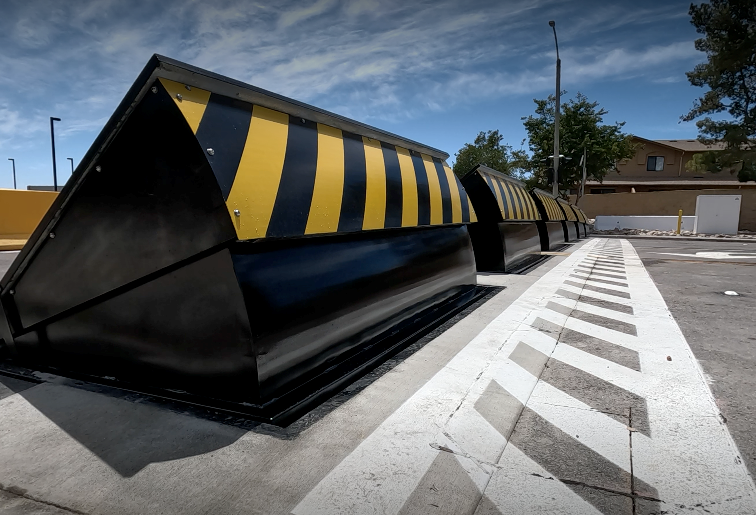Some Known Incorrect Statements About Wedge Barriers
Wiki Article
Unknown Facts About Wedge Barriers


The spring pole 58 is combined to a webcam(e. g., cam 80 displayed in FIG. 4) of the lifting system 50. The springtimes 60 disposed regarding their website the springtime rod 58 are kept in compression by spring sustains 62, including a repaired springtime support 64. That is, the set spring assistance 64 is fixed loved one to the structure 14 and the rest of the bather 10.
Not known Factual Statements About Wedge Barriers
The staying force applied to the cam to deploy release wedge plate 16 may might provided given an electromechanical actuator 84 or other various other. The spring assembly 54 and the actuator 84(e. Wedge Barriers. g., electromechanical actuator)might run with each other to convert the webcam and raise the wedge plate 16.
As pointed out over, the spring setting up 54 exerts a consistent force on the cam, while the electromechanical actuator might be regulated to apply a variable pressure on the webcam, thereby making it possible for the lifting and decreasing( i. e., releasing and withdrawing )of the wedge plate 16. In specific personifications, the constant pressure used by the spring assembly 54 might be adjustable. g., electromechanical actuator) is impaired. As will be appreciated, the springtime assembly 54 might be covered and safeguarded from particles or other components by a cover plate(e. g., cover plate 68 shown in FIG. 4) that might be significantly flush with the elevated surface area 38 of the foundation 14. As pointed out above, in the deployed setting, the wedge plate 16 serves to obstruct gain access to or travel beyond the obstacle 10. The barrier 10(e. g., the wedge plate 16 )might obstruct pedestrians or cars from accessing a residential or commercial property or path. As talked about over, the obstacle 10 is connected to the anchor 30 protected within the structure 14,

front brackets 71. Because of this, the affiliation settings up 72 may pivot and rotate to allow the collapse and extension of the affiliation assemblies 72 throughout retraction and implementation of the bather 10. The link assemblies 72 reason movement of the wedge plate 16 to be limited. As an example, if a vehicle is taking a trip towards the released wedge plate 16(e. As an example, in one situation, the safety legs 86 might be prolonged duringupkeep of the obstacle 10. When the safety and security legs 86 are released, the safety and security legs 86 support the weight of the wedge plate 16 versus the surface area 12. As a result, the lifting system 50 might be shut down, serviced, gotten rid of, replaced, etc. FIG. 5 is partial perspective sight of an embodiment of the surface-mounted wedge-style obstacle 10, highlighting the web cam 80 and the web cam surface areas 82 of the lifting system 50. Specifically, two cam surfaces 82, which are described as reduced camera surface areas 83, are positioned below the webcam 80. The lower cam surfaces 83 might be dealt with to the surface 12 (e. For instance, the lower web cam surfaces 83 and the placing plate 85 may develop a solitary piece that is safeguarded to the support 30 by screws or various other mechanical bolts. Furthermore, two camera surfaces 82, which are referred to as top cam surface areas 87, are positioned above the read the article camera 80 and paired to (e. In other personifications, stepping in layers or plates may be placed in between the surface 12 and the reduced camera surfaces 83 and/or the wedge plate 16 and the top web cam surfaces 87 As discussed above, the webcam 80 converts along the webcam surface areas 82 when the wedge plate 16 is raised from the withdrawed setting to the released position. Additionally, as mentioned above, the springtime setting up 54 (see FIG. 3 )might supply a force acting upon the camera 80 in the direction 102 using springtime rod 58, which might lower the force the electromechanical actuator 84 is called for to apply to the webcam 80 in order to activate and raise the wedge plate 16. 1 )to the deployed setting(see FIG. 4). As shown, the web cam 80 includes track wheels 104(e. g., rollers), which call and convert along the webcam surface areas 82 during procedure.
Report this wiki page